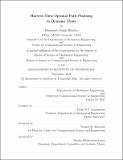Harvest-Time Optimal Path Planning in Dynamic Flows
Author(s)
Bhabra, Manmeet Singh
DownloadThesis PDF (30.23Mb)
Advisor
Lermusiaux, Pierre F.J.
Terms of use
Metadata
Show full item recordAbstract
The past decade has seen an increasing use of autonomous vehicles (propelled AUVs, ocean gliders, solar-vehicles, etc.) in marine applications. For the operation of these vehicles, efficient methods for path planning are critical. Path planning, in the most general sense, corresponds to a set of rules to be provided to an autonomous robot for navigating from one configuration to another in some optimal fashion. Increasingly, having autonomous vehicles that optimally collect/harvest external fields from highly dynamic environments has grown in relevance. Autonomously maximizing the harvest in minimum time is our present path planning objective. Such optimization has numerous impactful applications. For instance, in the case of energy optimal path planning where long endurance and low power are crucial, it is important to be able to optimally harvest energy (solar, wind, wave, thermal, etc.) along the way and/or leverage the environment (winds, currents, etc.) to reduce energy expenditure. Similarly, autonomous marine cleanup or collection vehicles, tasked with harvesting plastic waste, oil spills, or seaweed fields, need to be able to plan paths that maximize the amount of material harvested in order to optimize the cleanup or collection process.
In this work, we develop an exact partial differential equation-based methodology that predicts harvest-time optimal paths for autonomous vehicles navigating in dynamic environments. The governing differential equations solve the multi-objective optimization problem of navigating a vehicle autonomously in a highly dynamic flow field to any destination with the goal of minimizing travel time while also maximizing the amount harvested by the vehicle. Using Hamilton-Jacobi theory for reachability, our methodology computes the exact set of Pareto optimal solutions to the multiobjective path planning problem. This is completed by numerically solving a reachability problem for the autonomous vehicle in an augmented state space consisting of the vehicle’s position in physical space as well as its harvest state. Our approach is applicable to path planning in various environments, however we primarily present examples of navigating in dynamic ocean flows. The following cases, in particular, are studied. First, we validate our methodology using a benchmark case of planning paths through a region with a harvesting field present in a halfspace, as this case admits a semi-analytical solution that we compare to the results of our method. We next consider a more complex unsteady environment as we solve for harvest-time optimal missions in a quasi-geostrophic double-gyre ocean flow field. Following this, we provide harvest-time optimal paths to the highly relevant issue of collecting harmful algae blooms. Our final case considers an application to next generation offshore aquaculture technologies. In particular, we consider in this case path planning of an offshore moving fish farm that accounts for optimizing fish growth. Overall, we find that our exact planning equations and efficient schemes are promising to address several pressing challenges for our planet.
Date issued
2021-09Department
Massachusetts Institute of Technology. Department of Mechanical Engineering; Massachusetts Institute of Technology. Center for Computational Science and EngineeringPublisher
Massachusetts Institute of Technology